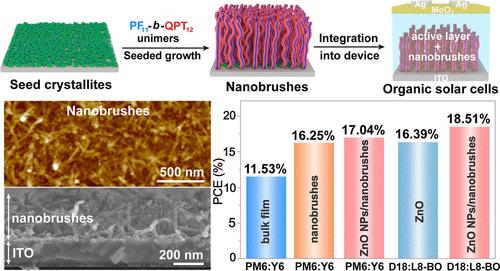Surface-Emanated Vertical Organic Semiconducting Nanobrushes
IF 14.4
1区 化学
Q1 CHEMISTRY, MULTIDISCIPLINARY
引用次数: 0
Abstract
Polymer self-assembly offers an important route to construct well-defined nanostructures. However, it remains challenging to assemble polymers into vertically oriented nanostructures. Here, we use a seed-induced confinement self-assembly strategy to construct vertically aligned semiconducting nanobrushes from polyfluorene-based polymers on conductive substrates. Mechanism studies elucidate that the immobilized seeds on the substrate initiate the vertical growth of nanobrushes, and supercritical drying as well as the rigid charged coronas collectively contribute to retaining the vertical architecture. This process enables nanobrushes with ∼40× higher charge mobilities than their bulk film counterparts. Thus, inverted organic solar cells using the nanobrushes as the electron transporting layer (ETL) exhibit a record power conversion efficiency of 18.51% as a result of increased ETL texturing and the ETL-active layer interface favoring electron extraction. Moreover, our approach also enables the uniform growth of nanobrushes on a nanoporous photoanode (bismuth vanadate) for photoelectrochemical water splitting, improving catalyst distribution and electron transfer. Our work presents a feasible approach to fabricating challenging vertical polymer nanostructures, thereby unlocking the tremendous potential of conjugated polymers in optoelectronic applications.

求助全文
约1分钟内获得全文
求助全文
来源期刊
CiteScore
24.40
自引率
6.00%
发文量
2398
审稿时长
1.6 months
期刊介绍:
The flagship journal of the American Chemical Society, known as the Journal of the American Chemical Society (JACS), has been a prestigious publication since its establishment in 1879. It holds a preeminent position in the field of chemistry and related interdisciplinary sciences. JACS is committed to disseminating cutting-edge research papers, covering a wide range of topics, and encompasses approximately 19,000 pages of Articles, Communications, and Perspectives annually. With a weekly publication frequency, JACS plays a vital role in advancing the field of chemistry by providing essential research.

 求助内容:
求助内容: 应助结果提醒方式:
应助结果提醒方式:


